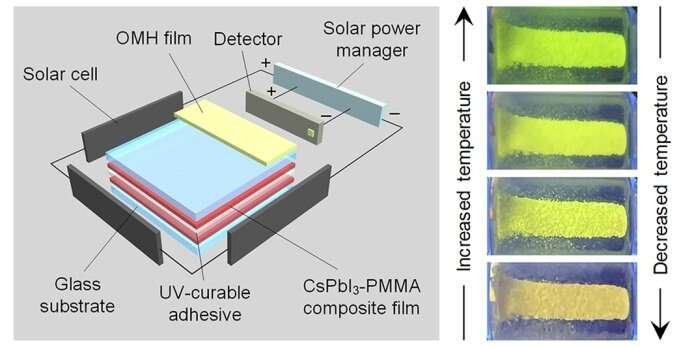
With the development of IoT technology, demands for integrating low-power-consumption electronic devices with power supply modules are rapidly increasing so as to develop more new self-powered devices. As members of the power supply family or photonic devices, luminescent solar concentrators (LSCs) are important supplements for the existing photovoltaic systems and show potential advantages in the self-powering of buildings.
In addition, LSCs can drive some low-power-consumption devices and are also excellent candidates for self-powered devices. Recently, some practical LSCs-based applications have been reported, such as the LSC greenhouse, visible light communications, and noise barrier panels. However, there are few reports concerning the integration of low-power-consumption devices with LSCs. Some pioneering work is still required to demonstrate the application of LSCs on self-powered smart products.
Recently, Shuhong Xu and Chunlei Wang of Southeast University and colleagues published a manuscript entitled “Glass-compatible and self-powered temperature alarm system by temperature-responsive organic manganese halides via backward energy transfer process” in the Journal of Energy Chemistry.
In this paper, the authors show a new type of single-emitted PEA2MnBr2I2 organic manganese halide (OMH) with reversible temperature-responsive fluorescence through the backward energy transfer from self-trapped states to 4T1 energy level of Mn2+.
Such OMHs exhibit a 4-fold enhancement in PL intensity ranging between 303 to 393 K, which can meet the needs of temperature-sensing in daily life scenarios and is available for designing “off-on” temperature alarm. More importantly, such OMHs do not show any spectral overlap with the LSCs, which avoids the problem of calibration errors induced by interference between thermal-responsive signal light and the emission of LSCs. Moreover, it also simplifies the temperature calibration system where only a simple low-power-consumption circuit based on photoresist is needed instead of a complex spectrometer system.
Based on the temperature-responsive OMHs and LSCs, a self-powered temperature alarm system on the glass substrate is fabricated for the first time. It can visually calibrate the temperature with LED indicators, and its practical operation is carried out in ambient light.
How to give light-capturing ‘solar-cell boosters’ a bright future
Pengfei Xia et al, Glass-compatible and self-powered temperature alarm system by temperature-responsive organic manganese halides via backward energy transfer process, Journal of Energy Chemistry (2022). DOI: 10.1016/j.jechem.2022.09.036
Citation:
A new type of organic manganese halide with reversible, temperature-responsive fluorescence (2022, October 20)
retrieved 20 October 2022
from https://techxplore.com/news/2022-10-manganese-halide-reversible-temperature-responsive-fluorescence.html
This document is subject to copyright. Apart from any fair dealing for the purpose of private study or research, no
part may be reproduced without the written permission. The content is provided for information purposes only.
Stay connected with us on social media platform for instant update click here to join our Twitter, & Facebook
We are now on Telegram. Click here to join our channel (@TechiUpdate) and stay updated with the latest Technology headlines.
For all the latest Technology News Click Here
For the latest news and updates, follow us on Google News.
